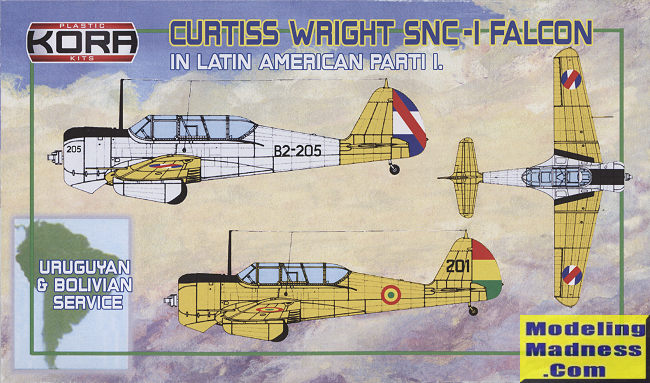
| KIT #: | KPK 72090 |
| PRICE: | 399 Koruna (about $17.50 at today's rate) |
| DECALS: | Five options |
| REVIEWER: | Scott Van Aken |
| NOTES: | Short run with resin and vacuform parts |

| HISTORY |
Developed at the Curtiss-Wright St. Louis factory, the CW-22 was developed from the CW-19 via the single-seat CW-21 light fighter-interceptor. The prototype first flew in 1940. With less power and performance than the CW-21, the two-seat, low-wing, all-metal CW-A22 had retractable tailwheel landing gear, with the main gear retracting rearward into underwing fairings.
The CW-22 was seen as either a civilian sport or training monoplane or suitable as a combat trainer, reconnaissance and general-purpose aircraft for military use. The prototype CW-A22 Falcon (U.S. civilian registration NC18067) was used as a company demonstrator and is one of four of the type still in existence. An SNC-1 is on display at the U.S. Navy's National Museum of Naval Aviation, at NAS Pensacola, Florida.
The main customer for the aircraft equipped with the Wright R-975 Whirlwind air-cooled radial engine was the Royal Netherlands East Indies Army Air Force and 36 were exported. The aircraft had to be delivered to the Dutch in Australia due to the advancing Japanese forces. A developed version, the CW-22B, was sold to Turkey (50), the Netherlands East Indies (25) and in small numbers in South America. Some of the Dutch aircraft were captured and operated by the Imperial Japanese Army Air Force. The CW-22 and CW-22B were armed with two machine guns, one fixed.
An unarmed advanced training version (CW-22N) was demonstrated to the United States Navy. To help to meet the expanding need for training, the Navy ordered 150 aircraft in November 1940. Further orders brought the total to 305 aircraft which were designated SNC-1 Falcon.
| THE KIT |
 Kora
started out doing resin kits and has since graduated to mostly injected
plastic kits. This one is fairly recent and has a bag of resin parts. It
still has a vacuformed canopy, of which two are supplied. Resin is used for
the seats, landing gear oleo scissors, wheels, engine and the mounting areas
for the wheel wells.
Kora
started out doing resin kits and has since graduated to mostly injected
plastic kits. This one is fairly recent and has a bag of resin parts. It
still has a vacuformed canopy, of which two are supplied. Resin is used for
the seats, landing gear oleo scissors, wheels, engine and the mounting areas
for the wheel wells.  Instructions
are well done and provide a nice side detail shot of the completed interior
to help you. Colors are provided in either Humbrol or Gunze references
(the numbers start with H), as well as generic names. Markings are provided
for five planes. Three are Uruguayan and differ by fuselage codes. They are
bare metal fuselage with yellow on the whings and tail, though one has no
yellow on the tail. The other two are from Bolivia and are overall yellow.
They differ only by serial number. The decals are nicely printed and should
work just fine. Kora has also included a set of masks for the wing walk
areas.
Instructions
are well done and provide a nice side detail shot of the completed interior
to help you. Colors are provided in either Humbrol or Gunze references
(the numbers start with H), as well as generic names. Markings are provided
for five planes. Three are Uruguayan and differ by fuselage codes. They are
bare metal fuselage with yellow on the whings and tail, though one has no
yellow on the tail. The other two are from Bolivia and are overall yellow.
They differ only by serial number. The decals are nicely printed and should
work just fine. Kora has also included a set of masks for the wing walk
areas.
| CONCLUSIONS |
It looks like a fairly straight-forward short run kit. Perhaps not for the bare beginner into these types, but nothing really difficult for the experienced. I like that you get two canopies as it is good to have some insurance just in case. If you like trainers, then this would be worth considering.
| REFERENCES |
https://en.wikipedia.org/wiki/Curtiss-Wright_CW-22
June 2019
Copyright ModelingMadness.com. All rights reserved.
If you would like your product reviewed fairly and quickly, please contact the editor or see other details in the Note to Contributors.